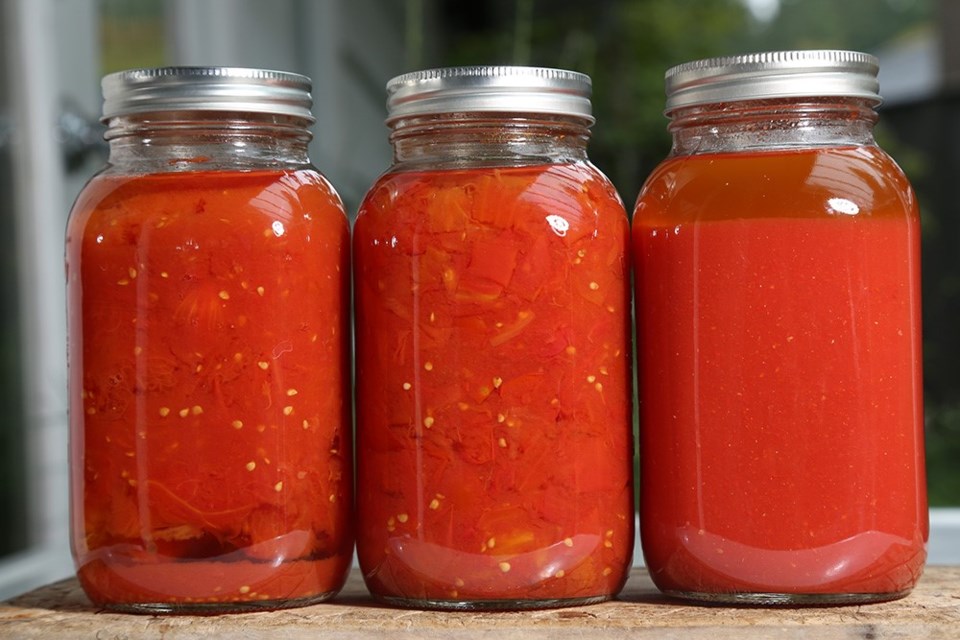During this beautiful season of tomato rains — the time of year when the season changes sharply from summer to fall, and the first meaningful rain falls in tandem with the processing of bushels of tomatoes — the remarkable connection between healthy living soil and nutrient-dense food, is particularly apparent.
The considerable time that it takes to sort, wash, peel, season, dry, dehydrate, process and preserve tomatoes, invites reverence, gratitude, and sequestration of every possible molecule of goodness offered by these most magnificent and sensual of fruits.
I know that our own tomatoes, grown lovingly from seed in living soil enriched with trace minerals, compost teas, worm castings, and beneficial fungi, are as nutrient-dense as they look. I am confident, too, that our bulk tomatoes, purchased from an organic, regenerative farm, are equally nutrient-dense — or almost.
Tomatoes, while not native to Canada, are one of our best-loved crops. Statistics Canada reports that in 2019, tomatoes accounted for 22 per cent of all field-grown crops, and 37 per cent of greenhouse crops grown by Canadian farmers.
Those percentages track more-or-less here in my family’s food gardens as well. The pruning, primping, feeding and harvesting of several varieties of grab-and-go determinate (bush) and indeterminate (vine) tomatoes for immediate consumption and for oven-drying, is an early morning ritual that I have come to love. One that feeds body and soul in equal measure.
We leave the care and feeding of the 150-plus kilos of San Marzano tomatoes that we put up annually to Okanagan and Similkameen Valley farmers like Klipper’s Organic Acres and Stoney Paradise, whose terroir and patience best suit the fussbudget temperament of these pedigreed fruits.
Extreme and unpredictable weather events visited upon North Shore gardens these recent years, are simply not conducive to field growing volumes of specialty tomatoes. Regardless, I am happy to support farmers living and working hard in the province’s bountiful rain shadows, and pay a small premium for their extraordinary, often heroic efforts.
After discovering that much or most of a tomato’s nutritional and antioxidant benefits reside in or on the skin and seeds, I abandoned the nonna-inspired traditions of blanching and peeling tomatoes before canning, and separating the pulp from the skins and seeds before making passata (purée).
Most recently, after reading nutrition-farming advocate Dr. Zach Bush’s delightful suggestion to harvest snack-size cherry tomatoes from the vine using one’s teeth, to consume 100 per cent of the “microbiome intelligence” of the microscopic peach fuzz-like hairs on the fruits — they drop off apparently, soon after harvest — I committed to putting up almost all of our San Marzanos, and all of our cherries, in their gorgeous, nutrient-dense skins.
The dozen or so kilos that are peeled and canned whole delegate skins to the dehydrator or smoker, which turn them into très élégante tomato crisps for garnishes or eating fresh, drizzled with olive oil and sea salt, or to be powdered for use as a nutritious and delicious colour or flavour.
Take a deep dive into the nutritional benefits of eating tomato skins, and you may never blanch again. I am confident that we retain all of the antioxidant, anti-inflammatory, and chronic disease preventing benefits of our canned tomatoes, by cleaning, chopping (or halving) and processing skin-on, or puréeing whole fruits before processing.
We did not abandon caution, however. The tomatoes were well washed, then boiled hard before bottling. Also, in deference to the generations of nonnas whispering in the wind, worried over skin surface-borne pathogens, we added an extra 10 minutes to the recommended processing time.
Admittedly, before committing, I cooked mini test batches of skin-on chopped and puréed tomato recipes, testing for sweetness, bitterness and mouthfeel. Ripe tomatoes of course, contain optimal sugars, so the results were spectacular. Had the tomatoes been less ripe, we would have removed the skins to elevate sweetness.Those nonnas knew a thing or two.
Be sure to follow Health Canada's Safety Recommendations for canning low acid fruits like tomatoes, and purchase from trusted growers. Farmers’ Markets and farm stands are chock-full of organic tomatoes. For bulk orders, call ahead for pickup.
Laura Marie Neubert is a West Vancouver-based urban permaculture designer. Follow her on Instagram @upfrontandbeautiful, learn more about permaculture by visiting her Upfront & Beautiful website or email your questions to her here.
For a taste of permaculture, click on the YouTube link below:
(Video - Courtesy of West Vancouver Memorial Library)



